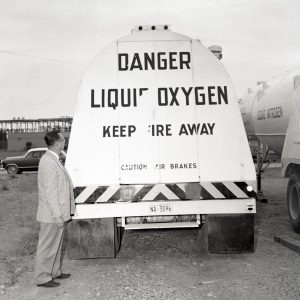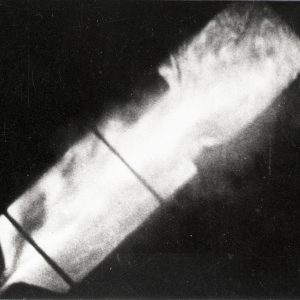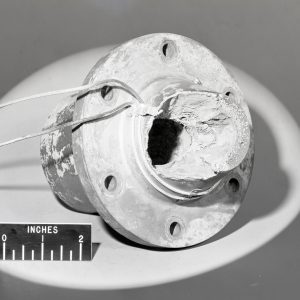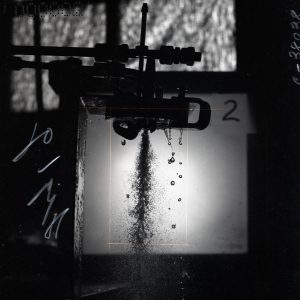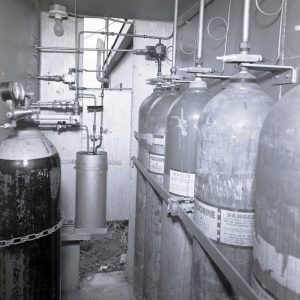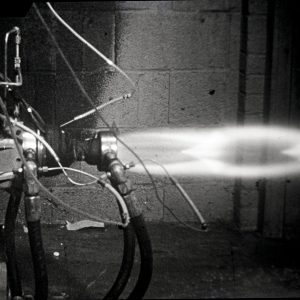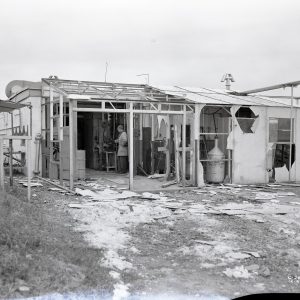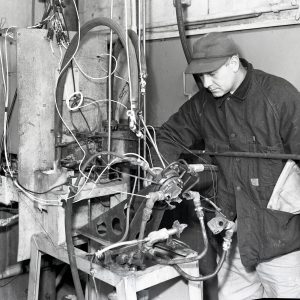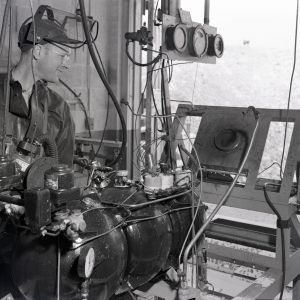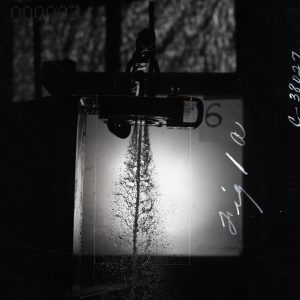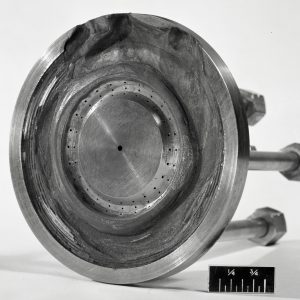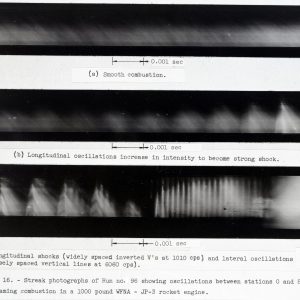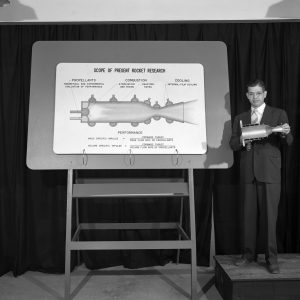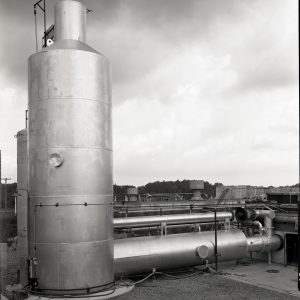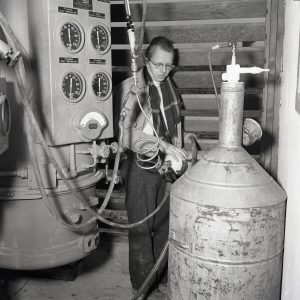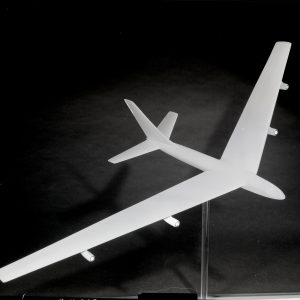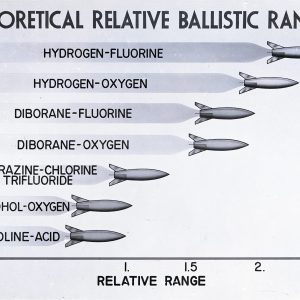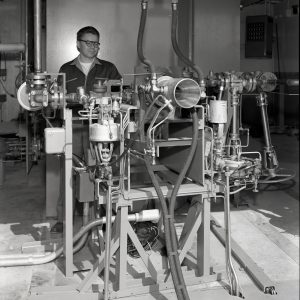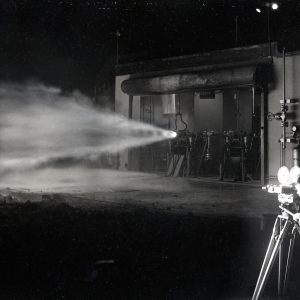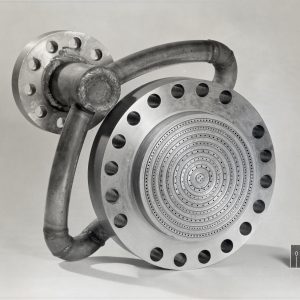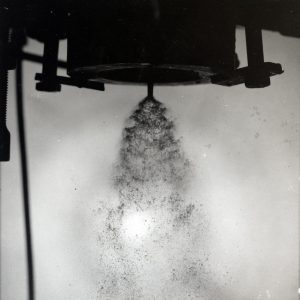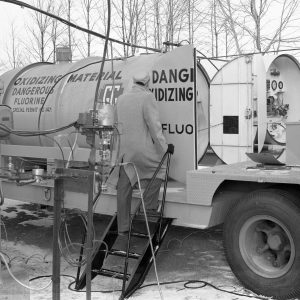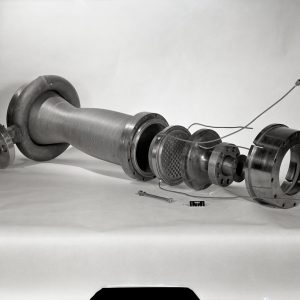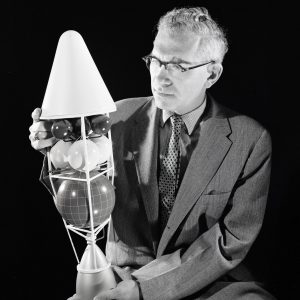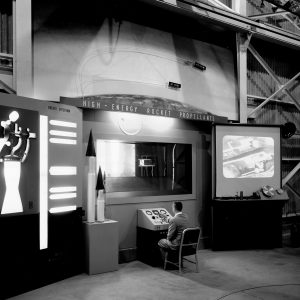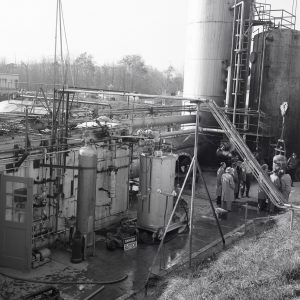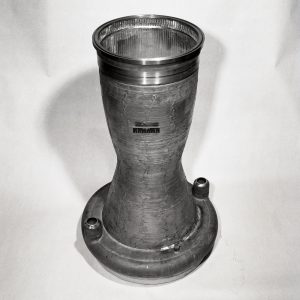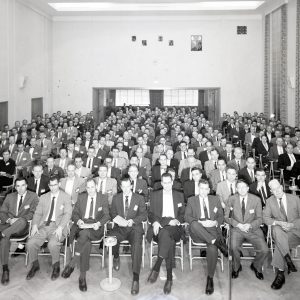Laying the Hydrogen Foundation
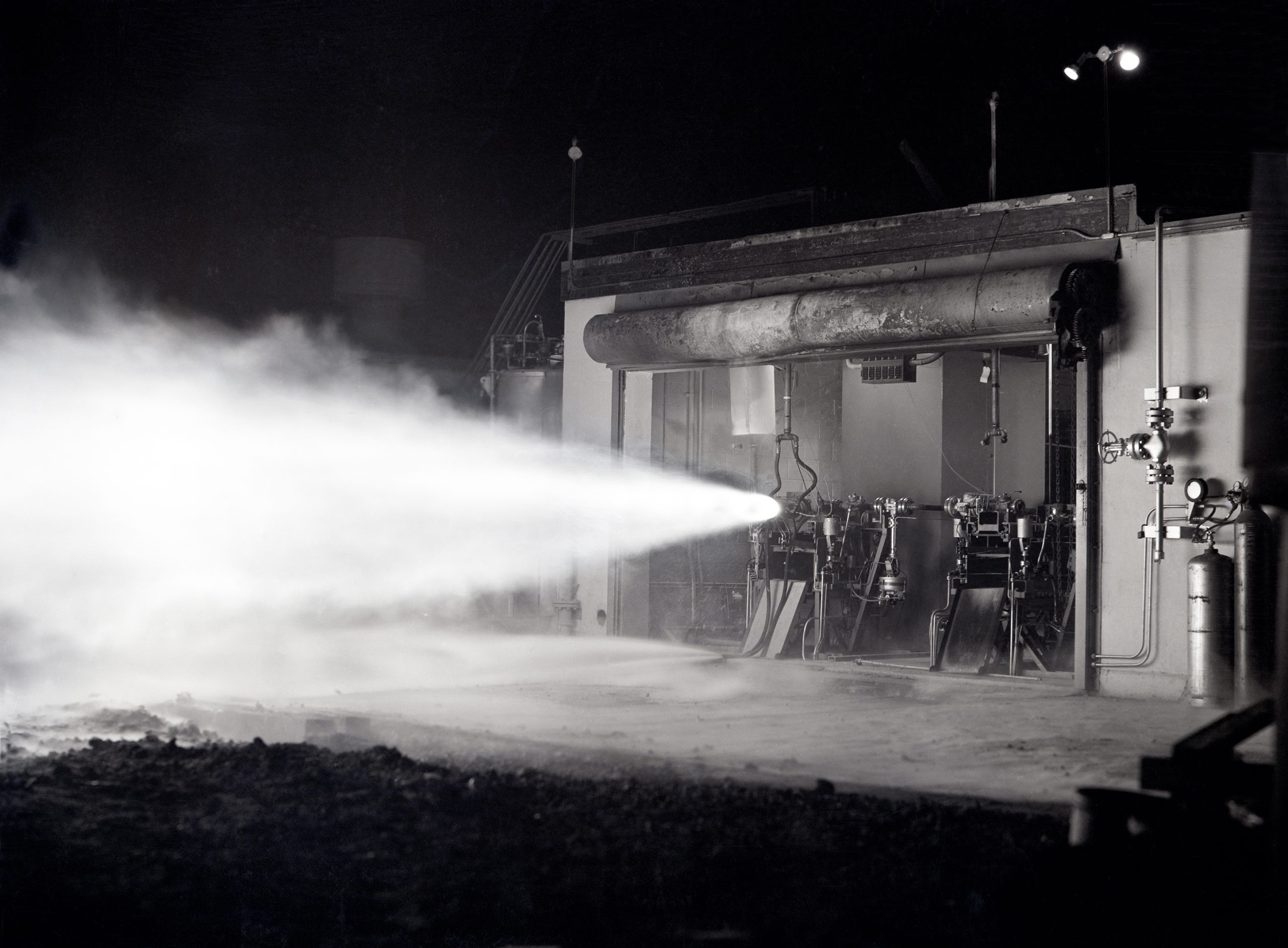
Overview
In late 1949, the National Advisory Committee’s (NACA) Cleveland laboratory (renamed the Lewis Flight Propulsion Laboratory) reorganized its research activities and expanded its rocket work. This included both an increase in the number of researchers and the bolstering of the Rocket Laboratory’s capabilities, including the acquisition of a hydrogen liquefier. Shortly thereafter, NACA Headquarters approved funding to add an exhaust scrubber to Cell 22 and to construct the new Rocket Engine Test Facility (RETF) adjacent to the Rocket Lab.
The researchers increasingly focused their efforts on hydrogen with either oxygen or fluorine as the oxidizer, while continuing ignition and altitude performance studies with hydrocarbon fuels. Although the NACA did not transition from airbreathing to rocket engines as quickly as the military during this period, the Rocket Lab work progressed and liquid hydrogen engines were successfully tested with both liquid oxygen and liquid fluorine by the time the Soviet Union launched Sputnik in October 1957.
The Oxidizers
The NACA researchers were interested in not only fuels, but also oxidants. Liquid oxygen was a high-performing and reliable oxidizer for both traditional and high-energy fuels. The rocket group tested the diborane, JP-4, kerosene, heptane, and ammonia fuels with liquid oxygen at the Rocket Lab in the late 1940s and 1950s. These tests, however, were primarily to investigate the fuel or experimental component (such as injectors) and not the already proven liquid oxygen.
Fluorine, however, offered significantly better theoretical performance than oxygen and had the benefit of being hypergolic (self-igniting). Fluorine’s inherent toxicity and corrosiveness presented both substantial handling and cleanup issues that needed to be addressed. The danger was such, that the transportation of relatively small amounts of fluorine to the laboratory in the early 1950s required police escorts and preapproved routes. NACA engineers assuaged the transportation situation by designing a unique cryogenic trailer that allowed the liquefication of gaseous fluorine at the Rocket Lab site.
In 1948, the NACA researchers began testing fluorine with diborane in Cell 31 at the rear of the Rocket Lab complex. The runs were among the nation’s very first to use liquid fluorine in engines. The found that diborane’s high combustion temperatures quickly melted the nozzle. The researchers were eventually able to cool the injectors long enough to obtain data, but ruled diborane out as a partner for fluorine.
In the early 1950s, small rocket engines were run in various Rocket Lab test cells to test fluorine with jet fuel, ammonia, and hydrazine. The NACA engineers also became interested in improving the performance of current missiles, which operated on JP-4 and liquid oxygen, by using a mixture of fluorine and oxygen (FLOX). The inclusion of fluorine increased provided better ignition and energy levels than pure oxygen. In the mid-1950s, several Rocket Lab cells were used to test various FLOX mixtures with different hydrocarbon fuels.
Documents
- Hydrogen-Fluorine and Hydrogen-Oxygen Research at Lewis (1961)
- Investigation of Liquid diborane and LOX combination in 100lb engine (1949)
- Internal film cooling of a 1000lb ammonia and LOX engine (1951)
- Performance of chlorine trifluoride-hydrazine combination in 100lb engine (1949)
- Investigation of liquid fluorine and liquid diborane combination in 100lb engine (1951)
- Investigation of liquid fluorine and liquid ammonia in a 100lb engine (1953)
- Performance of JP-4 fuel with FLOX mixtures in a 1000lb engine (1958)
- Experimental performance with a FLOX and JP-4 mixture (1955)
Screaming Engines
Combustion oscillations were an inherent and unpredictable element of early high-performance rocket engines. Energy released during combustion frequently spurred cyclical vibrations, or oscillations, that could destroy the engine. These oscillations, referred to as chugging when low-frequency and as screech or screaming when high-frequency, could overstress metal components or increase temperatures to the point of failure. Screech produces a high-pitched scream that is audible above the engine roar.
In the 1950s, an eight-year program was conducted at the Rocket Lab to determine the root causes of screech and develop preventative measures. It sought to identify the combustion conditions that produced the vibrations and methods of testing combustion stability. The researchers tested different injectors, combustion chamber geometries, propellant combinations, and mixture ratios. High-speed cameras and oscilloscopes were used to document and measure the screaming phenomena.
The effort determined that the installation of longitudinal fins in the combustion chamber reduced the oscillations, and that the hydrogen and oxygen combination produced lower levels of screech than other propellant combinations. The combustion instability and screech investigations were expanded upon in the 1960s with testing of larger liquid hydrogen-oxygen engines at the Propulsion Systems Laboratory and the RETF.
Documents
- Combustion instability in an acid-heptane rocket (1951)
- Photographic investigation of combustion in a transparent engine (1953)
- Effect of Fuels on Screaming in 200-pound-thrust Liquid-oxygen Engine (1956)
Transition to Hydrogen
The initial NACA research revealed that only hydrogen, beryllium, pentaborane, and diborane possessed higher combustion temperatures than traditional hydrocarbon fuels. Hydrogen and diborane required special handling procedures, whereas beryllium and pentaborane produced serious toxicity. Hydrogen, with its high specific impulse and nontoxic exhaust, appeared to be the most promising. The potential of hydrogen (both gaseous and liquid) as a rocket fuel had been recognized for decades, but the NACA researchers bypassed it in the 1940s because of ongoing testing at other institutions. By 1950, however, this external work was winding down.
NACA Lewis wanted to expand upon the hydrogen work done by other organizations by concentrating on liquid hydrogen and using larger engines. Liquid hydrogen’s -423 F boiling point, however, made it one of the most difficult chemicals to obtain in the early 1950s. The laboratory was able to obtain a surplus hydrogen liquefier from the U.S. Air Force in 1954 to create the necessary liquid hydrogen. The subsequent construction of a commercial liquefaction plant in the local area alleviated any shortages. In addition, the laboratory upgraded Cell 22’s thrust stand and added a large scrubber to remove any toxins from the rocket exhaust before they were expelled into the atmosphere. Cell 22 became the center of the NACA’s hydrogen testing, with either oxygen or fluorine, in the 1950s.
NACA’s First Liquid Hydrogen Rockets
In the fall of 1954, NACA researchers prepared Cell 22 for the first significant attempt to operate a liquid-hydrogen-fueled rocket. In the evening of November 23, a 5,000-pound -thrust liquid hydrogen and liquid oxygen engine was successfully fired, producing 90 percent of the theoretical thrust. The test was significant for both the unique propellant combination and the fact that the engine was significantly more powerful than the hydrogen engines previously used at other organizations to use liquid hydrogen.
The performance of the liquid hydrogen and liquid oxygen engine waned during follow up runs in the ensuing weeks. The researchers spent most of 1956 reconfiguring the fuel injector, which mixes the fuel and oxidizer as they enter the combustion chamber. A new round of tests in December 1955 proved to be again disappointing. The engineers redesigned the injector to include numerous small tubes through which the hydrogen and oxygen flowed. The new configuration was effective, and the modified liquid hydrogen and liquid oxygen engine was successfully fired at Cell 22 in February 1956.
The researchers turned their attention to the hydrogen-fluorine combination. Initial attempts to pair fluorine with liquid hydrogen in Cell 22 failed due to inadequate cooling. The first successful liquid hydrogen and fluorine test run took place in March 1956. Although only four seconds in duration, the test run produced the highest propellant performance to date at the Rocket Lab. Nonetheless, there remained much work to be done before hydrogen-fluorine engines became a reality.
Documents
NACA Shares Its Fuels Work
The Lewis laboratory scheduled two events for the fall of 1957 to demonstrate aspects of its research to a larger audience. The first was the NACA’s three-day triennial Inspection in October in which invited guests toured the laboratory to hear about the latest activities. During the preparations, NACA officials adamantly prevented the Lewis speakers from mentioning spaceflight in their presentations. Just days beforehand, however, the Soviet Union launched its Sputnik satellite, and the nation was obsessed with space. The officials quickly restored the spaceflight topics to the presentations. A highlight was the high-energy rocket fuels talk at the recently completed RETF facility.
The second event was the NACA Flight Propulsion Conference in November to inform military and industry representatives on the laboratory’s propulsion work. A team from the Rocket Lab was scheduled to present a paper on fuels with high specific impulses. They planned to use data from the test of a 5,000-pound-thrust hydrogen and fluorine rocket in Cell 22 to demonstrate hydrogen’s ability to provide regenerative cooling.
Throughout the fall, the team sought to replicate a hydrogen-fluorine engine firing that had occurred in March 1955, but with the addition of a regenerative cooling system. During one run earlier in the month, a fluorine leak ignited the test cell roof. After repairs were made, the researchers worked continuously for days to resolve the persistent problems. The hydrogen-fluorine rocket finally fired properly at 6 a.m. on the day of the conference. The researchers quickly processed the test data and presented it to their colleague as he delivered his paper. He concluded his talk with, “A small engine has been regeneratively cooled successfully; bigger engines should prove easier.”
High-Energy Rocket Propellant Talks at NACA Inspection (1957)

